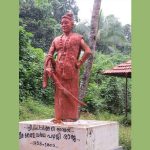Vellore Mutiny
The First Major Uprising of the Sepoys against the British
For nearly two centuries since the first Englishmen began trading in India, the Indo-British relations were largely one of cultural assimilation, and were reciprocal in nature, when the British expanded their influence by a mixture of diplomacy, tact, and only occasionally, by force. All that was changing by the end of the18th Century. And at the dawn of the 19th Century, the English East India Company had adopted a visibly imperialistic approach, arrogantly backed by the racial prejudices of the British. Governor General Richard Wellesley (1st Marquess Wellesley), eulogizing himself on his ‘Taming the Tiger’, as he preferred to describe the defeat and killing of Tipu Sultan, had set in motion, policies that were bound to antagonize the Indians and erode the goodwill that generations of Britons before him had built up. Embedded in these policies which created the framework of the future British Raj were, ironically, the very seeds of ruination of that institution one day.
In no sphere of activity had the British been as successful with their cultural balancing act in winning over the Indian hearts, as they had been with the creation of the sepoy armies, staunchly loyal to the East India Company. The three Presidency Armies of Madras, Bengal and Bombay, had become the cornerstone and symbols of British power in the subcontinent by the early 19th Century. The men who made it happen – scores of officers, from ‘Old Cock’ Stringer Lawrence to Arthur Wellesley, later Duke of Wellington – were professionals who identified themselves with their men. A warm-hearted lot, they were alive to their troops’ sensitivities and respected their customs. They led, rather than lorded over their men. The sepoys, stout-hearted souls with strong soldierly leanings, long denied their proper dues by callous Indian rulers, responded with absolute loyalty, priding themselves in the superior discipline and training in the ‘Company’s Service’, and gave their best for the sheer glory of winning battles – love of adventure of a unique kind.
Even when the East India Company’s higher echelons began turning arrogant with their new imperialistic approach, the sepoys remained more or less insulated from its ill-effects, because of a sensible officer corps that largely stuck to the traditional ways of commanding their troops. But the cancer was spreading; it wouldn’t be long before the officers, at least a considerable number of them too, fell prey to the ignoble tendencies of snobbery. They would start taking the sepoys’ loyalty for granted. Still, it would take another half a century for the malignancy to become full-blown, and things to come to a head. The day of reckoning would come for the British on the 10th of May 1857, in the cantonment at Meerut, when the historic Sepoy Rebellion broke out. It would impact the Indian history as few other occurrences ever did. Even if the sepoys could not win and overthrow the British, they made a point – India was too big a country, too serious an affair, to be left in the hands of a bunch of rapacious businessmen and crude mercenaries. It was the death-knell of the East India Company. The Crown took over governance, and strangely, set India irrevocably on her path to freedom. Thus, the sepoys who conquered India for the British, ironically enough, made the first move that would put her on the road to freedom and self-governance.
More than half a century before the Meerut outbreak, the sepoys fired a warning shot at Vellore in Southern India, which gave the British an inkling of what grief would befall them, should they ever be insensitive to the native troops. But they either chose to ignore it, or to underplay the episode to cover up their folly. Interestingly, the Vellore Mutiny, the first ever instance of dissidence of a major nature by Indian troops against the British, resulted from the sepoys being provoked by certain orders which offended their religious and cultural sensibilities – circumstances almost identical to that which would find their brethren in the north, in open rebellion in 1857. A one-day affair, as bloody as any mutiny could be, it occurred on the 10th of July 1806, and takes the pride of place in our history as the first major revolt by Indian soldiers against the British. Small-scale mutinies by European officers had occurred in the 17th Century itself; the earliest having been recorded in 1674. The first known mutiny by Indian troops took place in Tellicherry in 1780, which was more in the nature of a small strike and was put down easily. It was followed by a slightly bigger one in Vizagapatam during the same year, wherein the sepoys shot and killed three British officers; the first instance of Europeans being killed by Indian mutineers. This mutiny too, was suppressed easily.
The main cause of the Vellore Mutiny was the suspicion among the sepoys that the British were deliberately attempting to convert them into Christianity, fuelled to a good extent by the general resentment that was building up among the populace against the alien rule. The consternation arose from a new set of regulations introduced to bring about the uniformity of appearance of the men. These required them to shave off their beards, trim the moustaches, and stop wearing earrings and painted caste-marks on their foreheads. Even more offending to the troops was a newly patterned turban, closely resembling a hat, popularly worn by the Indian converts to Christianity, whom the sepoys despised.
The 2/4th Madras Infantry, stationed at Vellore, was the first unit to resent wearing the turbans (2nd Battalion of the 4th Madras Regiment, as per the way each regiment was divided into two battalions since 1796). Ignoring their commanding officer’s voice of reason, the Army Headquarters reacted with tough disciplinary measures. The battalion was shifted to another station, and 21 men, perceived to be ringleaders, were brought to Madras, court-martialled and sentenced to 500 lashes each. This only added fuel to the fire, hardening the sepoys’ resolve, and there were rumblings of an organized resistance to the new dress regulations. The Commander-in-Chief, General Sir John Craddock, sensing trouble, suggested to the Governor that the orders on turbans be retracted. The Governor obstinately disagreed, arguing that it would undermine the discipline of the army.
On the night 9th/10th July, one whole battalion, the 2/23rd Madras Infantry, was permitted to sleep inside the fort in preparation for a parade early in the morning. The guards on duty for the night were from the 1/1st Madras Infantry and a British battalion, the 69th Foot. At 2:30 a.m. on the 10th, the sepoys of the two Madras battalions struck. Taken by surprise, almost all the British officers and soldiers were massacred. The few who escaped fought their way to the ramparts, and perched above the main gate, managed to hold out until it was daylight. Luckily for them meanwhile, the news of the outbreak had got to Colonel Rollo Gillespie, commanding the garrison at Arcot only 18 miles away, pretty fast. He promptly rode out to the rescue, with the 7th Madras Cavalry and a squadron of the British 19th Dragoons. As soon as his galloper guns fetched up at Vellore, the gate was blown open and the cavalry and the dragoons charged into the fort. The sepoys stood no chance. Some 350 of them perished; and though most of the rest escaped, a number of them were taken prisoner eventually from the countryside where they had dispersed to. More than a hundred of them were blown from the muzzle of the gun.
An enquiry conducted later, while coming to the conclusion that the introduction of the new dress regulations was the principal cause of the mutiny, also suggested the involvement of the sons of Tipu Sultan and their retainers, lodged as prisoners in the fort, in instigating the sepoys. Five of the retainers were sentenced either to death or long terms of imprisonment, while the princes themselves, in the absence of any conclusive evidence against them, were sent away to Calcutta. Sepoy Mustapha Beg of the 1/1st MI, who had divulged information on the mutiny earlier (and was jailed at that time having been considered insane, as the Indian officers had successfully convinced the commanding officer), was gifted 2000 pagodas and pensioned off on the pay of a subedar; he couldn’t have survived long among the sepoys anymore. The 1st and 23rd Regiments were disbanded, though the 1st was to be re-raised later. The offending turban was however withdrawn, and so were the other troublesome regulations, while the Governor and his officials responsible for the fiasco, the Commander-in-Chief, the Adjutant General, Colonel Agnew, who drafted the half-witted regulations, and his deputy, were all unceremoniously sacked.
The rescinding of the offending regulations, immediately after the suppression of the mutiny contained the resentment that had been building up in other cantonments. However, the authorities eventually found ways to introduce the dress regulations throughout the sepoy armies, cunningly advancing a theory that the Vellore Mutiny was part of a larger plot by the Muslims to overthrow the British. Nothing could have been further from the truth, for the simple fact that almost the entire lot of mutineers were Hindus – a typical instance of the British indulging in fissiparous propaganda to gain points. Essentially, the mutiny was the result of oafish obstinacy and blunder on the part of the top guns of East India Company. At least one officer is known to have saved the situation by merely being sensible. Colonel Montressor, commanding the Subsidiary Force at Hyderabad, nipped the trouble at the bud by simply cancelling the offending orders on his own responsibility.
Paradoxically, for all the fears of attempts at conversion of troops to Christianity, the British officers of the sepoy armies seemed to have been generally disinterested in any such initiative, if not totally against it. The general perception among the officers was that they would be much better off commanding the sepoys without the “nuisance from the damned missionaries”, since they – the sepoys – “had their own religions that they were perfectly happy with”. And they were sensible enough to be respectful of the religious sentiments of their men, which was one of the cardinal points that won them the loyalty of the troops at large. Therefore, it is only logical to assume that the mutiny would have had a lot to do with extraneous factors related to the contemporary socio-political unrest, precipitated by the establishment of an alien power. The religious part probably came in as a convenient detonator. Be that as it may, the tradition of the officer making his men’s religion his own, continues to be one of the most powerful motivating factors that maintain the Indian Army’s discipline and fighting edge to date.





